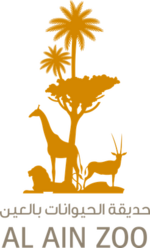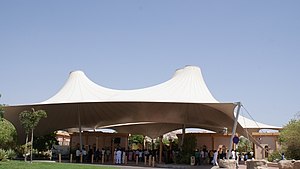This article has multiple issues. Please help improve it or discuss these issues on the talk page. (Learn how and when to remove these messages)
|
Al Ain Zoo (Arabic: حَدِيْقَة ٱلْحَيْوَانَات بِٱلْعَيْن, romanized: Ḥadīqat Ḥaywānāt Bil-ʿAyn), also "Al Ain Wildlife Park & Resort" [1] [6] or simply "Al Ain Wildlife Park" (Arabic: مُتَنَزَّه ٱلْعَيْن لِلْحَيَاة ٱلْبَرِيَّة, romanized: Mutanazzah Al-ʿAyn Lil-Ḥayāt Al-Bariyyah),[3] [7][8] is a 400-hectare (990-acre) zoo located in the foothills of Jebel Hafeet in Al Ain, Abu Dhabi, the United Arab Emirates. It is primarily composed of ungulates and herbivores, such as Arabian antelopes. It also holds oryx, eland, gazelle, and lechwe, as well as the rare white lion and Nubian giraffe. [9] There are 68 species of mammals, 88 species of birds and 35 species of reptiles available in the 50 hectares of zoo houses.[10]
| Al Ain Zoo | |
|---|---|
| حَدِيْقَة ٱلْحَيْوَانَات بِٱلْعَيْن | |
 | |
 Al Ain zoo entrance | |
 | |
| 24°10′33.89″N 55°44′18.57″E / 24.1760806°N 55.7384917°E | |
| Date opened | November 25, 1968 |
| Location | Al Ain, Eastern Region of the Emirate of Abu Dhabi, the UAE |
| Land area | 400 ha (990 acres) |
| Website | www |
History and fauna
editIn 1968 Sheikh Zayed bin Sultan Al Nahyan, the late Ruler of Abu Dhabi and President of the United Arab Emirates joined efforts and decided on founding a national zoo. This decision was born out of their genuine concern of the land's wildlife. In 1969 it was established by Shaikh Zayed Bin Sultan Al Nahyan and in 1972 it opened to the public.[13] Among the species they wanted to protect were ungulates such as the Arabian oryx.[14][15]
Today, the zoo hosts over 4,000 animals, some of them extinct in the wild, some endangered. It features a big cat house containing lions, mountain lions, jaguars, black panthers, leopards, and cheetahs.[16] In addition, it has a reptile house, monkey compounds, an aquarium, and an aviary. From February 2010 until July 2010, the Al Ain Zoo hosted the "Dinosaur Trail," a small section that includes around 15 to 20 mechanical dinosaurs with sensors, such as Tyrannosaurus rex. It included information about each dinosaur, living habits, natural habitat and basic features.[17]
In April 2019 the zoo began its expansion program in order to build new compounds' areas and sites, such as the conservation and breeding centres, African Safari, World Desert Zoo, and the Sheikh Zayed Desert Learning Centre.[18]
In March 2022, as the zoo intended to import wild African elephants from Namibia, the World Association of Zoos and Aquariums published its thoughts on the matter. They stated that according to their Code of Ethics it is essential from time to time to make such actions. This is needed in light of global efforts of conservation breeding programs, education programs, or basic biological studies. Having said that, they continued their statement that concluded that the zoo's intention to import African elephants does not meet WAZA's Code of Ethics. The outcome of that statement was the decision to terminate Al Ain Zoo membership in WAZA until further notice.[19]
Following that event and statement, on September 15, 2022, the European Association of Zoos and Aquaria (EAZA) also announced the termination of the membership of Al Ain Zoo in the United Arab Emirates. The zoo’s membership ended on December 31, 2022, following the decision of the EAZA Council that EAZA can no longer reasonably be expected to allow the institution to remain a member. The decision comes after careful examination of evidence related to importing wild-caught African elephants from Namibia, which the Council agreed constituted multiple breaches of EAZA Codes and Standards. [20][21]
Al Ain Zoo has implemented a sustainability initiative by cultivating 211.2 tons of plant-based food annually in a dedicated nursery. The zoo grows various local and non-local plant species like Sidr, Ghaf, Hibiscus, and others to ensure a steady food supply for its animals.
On August 14th it was reported that for the first time in years three Arabian sand cats were born in the zoo.[22]
Gallery
editSee also
editReferences
edit- ^ Forte, Pauline M. (2010-05-22). "Al Ain Wildlife Park: A night at the zoo". Retrieved 2019-04-14.
- ^ "Al Ain". The Report Abu Dhabi 2010. Oxford Business Group. 2010. pp. 171–176. ISBN 978-1-9070-6521-7.
- ^ Dāwūd, Muḥammad (2010-03-04). "منتزه العين يؤمن حياة كائنات مهددة بالانقراض" (in Arabic). Al-Bayan. Retrieved 2019-04-14.
- ^ Sanad, ʿAzzah (2010-04-09). "متنزه العين للحياة البرية بيئة تنبض بالجمال" (in Arabic). Al Ain: Al-Khaleej. Retrieved 2019-04-14.
- ^ "افتتاح متنزه الحياة البرية بحديقة الحيوانات بالعين". WAM (in Arabic). Al-Ittihad. 2017-04-20. Retrieved 2019-04-14.
- ^ "Al Ain". The Report Abu Dhabi 2010. Oxford Business Group. 2010. pp. 171–176. ISBN 978-1-9070-6521-7.
- ^ Dāwūd, Muḥammad (2010-03-04). "منتزه العين يؤمن حياة كائنات مهددة بالانقراض" (in Arabic). Al-Bayan. Retrieved 2019-04-14.
- ^ "افتتاح متنزه الحياة البرية بحديقة الحيوانات بالعين". WAM (in Arabic). Al-Ittihad. 2017-04-20. Retrieved 2019-04-14.
- ^ "Al Ain". The Rough Guide to Dubai. Rough Guides UK. 2016-11-01. ISBN 978-0-2412-9864-0.
- ^ "Family fun at Al Ain Zoo". gulfnews.com. 2008-03-29. Retrieved 2024-09-27.
- ^ Edmonds, J.-A.; Budd, K. J.; Al Midfa, A. & Gross, C. (2006). "Status of the Arabian Leopard in United Arab Emirates" (PDF). Cat News (Special Issue 1): 33–39.
- ^ Spalton, J. A. & Al-Hikmani, H. M. (2006). "The Leopard in the Arabian Peninsula – Distribution and Subspecies Status" (PDF). Cat News (Special Issue 1): 4–8.
- ^ "Family fun at Al Ain Zoo". gulfnews.com. 2008-03-29. Retrieved 2024-09-27.
- ^ "History". Al Ain Zoo. Retrieved 2019-03-18.
- ^ "Overview". Al Ain Zoo. Retrieved 2019-03-18.
- ^ "Al Ain". The Report Abu Dhabi 2010. Oxford Business Group. 2010. pp. 171–176. ISBN 978-1-9070-6521-7.
- ^ "Retracing the Land of the Lost in Al Ain". gulfnews.com. 2010-02-20. Retrieved 2024-08-14.
- ^ Sanad, ʿAzzah (2010-04-09). "متنزه العين للحياة البرية بيئة تنبض بالجمال" (in Arabic). Al Ain: Al-Khaleej. Retrieved 2019-04-14.
- ^ "Position Statement on Export of Wild African Elephants - WAZA".
- ^ "EAZA Terminates Membership of Al Ain Zoo" (PDF). eaza.net. European Association of Zoos and Aquaria (EAZA). 15 September 2022. Retrieved 7 Sep 2024.
- ^ "Al Ain Zoo advances ecological sustainability by growing 210+ tonnes of plant-based animal browse annually". gulfnews.com. 2024-04-15. Retrieved 2024-04-15.
- ^ "Al Ain Zoo welcomes three Arabian sand cats". gulfnews.com. 2024-08-14. Retrieved 2024-08-14.
- ^ WAM (2017-09-13). "EAD raises awareness on Abu Dhabi's natural heritage at ADIHEX 2017". The Gulf Today. Archived from the original on 2018-03-30. Retrieved 2018-03-30.
- ^ De Leon, J. P. (2014-05-26). "100th Arabian tahr, and twin tahrs welcomed in Al Ain". Gulf News. Retrieved 2018-04-03.
- ^ "Newborn Arabian tahr discovered on Jebel Hafeet". The National. 2015-03-12. Retrieved 2018-03-30.
External links
edit- Media related to Al Ain Zoo at Wikimedia Commons
- Official website